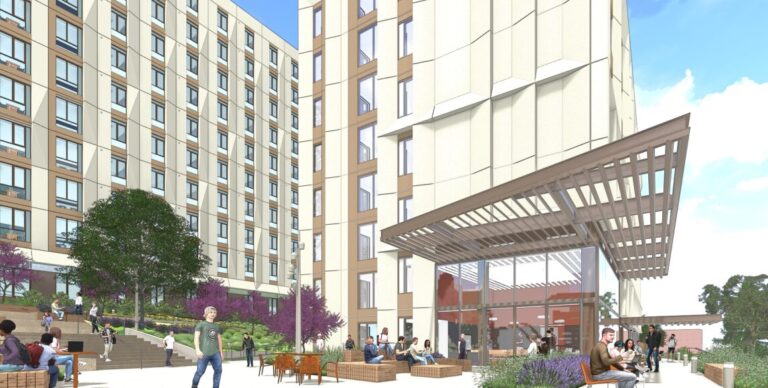The Art of Winning Work in Behavioral Health Facility Development

Winning funding or work in behavioral health facility development is part science, part art. And whether you’re a public health agency looking to address the needs of the community or a private contractor seeking a new opportunity, the niche can present a steep learning curve.
Attention and funding for behavioral health initiatives is increasing rapidly, from King County’s $1.25 billion levy in 2023 to California’s $6.38 billion Proposition 1 in 2024. But as opportunities rise, so does the bar for credibility and delivery. Washington State Department of Commerce received 80 funding requests for nearly $280 million across its behavioral health programs between 2023 and 2025, and to date have awarded $55 million to 22 projects.
As Eric Fedder, Project Director at PMA, explains, “They [awarding bodies] want to assign funding, and they’re not quite getting the right applicants or the right approach that’s justifying use of it…there are definitely opportunities out there for the right applicants and approach.”
Private developers and the broader AEC (architecture, engineering, and construction) community are also missing out on valuable partnerships. Behavioral health sits outside traditional procurement playbooks, which is why the “four walls and a roof approach” rarely pays off.
For both public agencies seeking to identify social services and private developers pursuing contracts, wins go to teams that engage early, align to community needs, and submit proposals with credible operations, realistic schedules, and a clear regulatory understanding.
How Can Agencies Secure Behavioral Health Funding?
Start by showing where the project fits local community needs, what outcomes it will deliver, and a realistic plan for bringing it to life. Eric Hoffman, Vice President, National Healthcare Sector Lead at PMA, sums it up neatly: “The intent of this whole process is not to just do the process. It’s to put a viable business there to help people with their needs.”
Prove readiness with pre-development
Bring early programming, conceptual design, site diligence, and defensible cost and schedule ranges. Be explicit about what is secured, what is pending, and how pre-development will work. Spell out the approvals you will seek, the sequence, and the critical path.
Name the delivery team and operator
De-risk delivery by showing who is accountable now, not later. A named healthcare architect, a general contractor with behavioral health experience, and/or an operator with a proven model signals control of schedule, budget, and licensing. As Fedder puts it, “I think the most sure way is to show this is a common team with behavioral health experience that has done this before. That’s a slam dunk versus an application that says, ‘we’ll go out competitively bid to a local GC market’.”
Show the regulatory path and timeline
Regulatory literacy wins awards. Identify the specific authorities, reviews, and inspections you must clear, then align milestones to real review durations. In Washington, that includes the Department of Health Construction Review. In California, consider applicable health facilities and local approvals. Present a schedule reviewers recognize as achievable and tie it to procurement and cash-flow timing.
Make the scorecard work for you
Weight your narrative to criteria that move points: track record, team readiness, regulatory plan, operating viability, and community alignment. Do not over-invest in low-weight details. Where permissible, propose a stage-gated or conditional award structure that releases funds as you hit progress points, with clear off-ramps if milestones are missed.
Document community alignment early
Treat engagement as mitigating risk by including community members as key stakeholders. Show how location logic, service mix, and neighborhood benefits were shaped by outreach, including municipal letters of support and note where community feedback changed the plan. If proposing a hub model, explain how it reduces trips, improves coordination, and builds public trust.
What Should Private Developers and AEC Firms Do Differently?
Win behavioral health work by frontloading the effort. Show up early, help shape the RFP/solicitation process in public forums, bring in a proven team and delivery model, and map risks from notice to opening.
Start before the RFP is written
Track notices, town halls, and open RFIs to understand strategy, geography, and timing, then ask constructive questions on the record. Andrew Bohnert, Vice President at PMA, says, “Growing the relationship over a period of time is really what’s needed.” He adds “The more a developer understands the local landscape and requirements the better.”
Approach the process as a strategic partnership
There are no shortcuts or back channels in public procurement, but there are open forums where input is both invited and valuable. Attend listening sessions, RFIs, and public briefings to understand the agency’s goals and constraints, then use those settings to share practical insights. Fedder notes agencies often “truly are seeking guidance on how to do this the right way,” yet few private voices step up. Constructive engagement helps shape realistic scopes and timelines, without crossing the line.
Demonstrate your track record and relevant experience
Public agencies assess risk through evidence. Name your partners, show prior behavioral health or adjacent healthcare projects, and make clear who is accountable for project delivery. Pre-aligned teams with relevant experience inspire more confidence than “build it later” approaches.
Invest in the mission
This sector rewards authenticity. Passion and purpose are competitive advantages because behavioral health projects can be personal and often involve vulnerable populations, sensitive topics, and complex human experiences. Valerie Freier, Project Director at PMA, emphasizes that success comes from “finding those sort of like-minded consultants and contractors who feel the same way… who really want and have a vested interest in rolling out these programs.”
Provide relevant timelines and de-risk the path
Map the regulatory path, approvals, and inspections you must clear, then align milestones to realistic review durations in these jurisdictions. Break the plan into measurable steps, flag dependencies, and show how risks will be managed. Grounded schedules and clear mitigation make it easier for public agencies to select you.
The path forward
Behavioral health projects move faster, and with fewer surprises, when someone is accountable for stitching intent, scope, and delivery together. A seasoned consulting partner keeps everyone honest on risk, roles, and readiness, and turns policy goals into realistic plans and timelines.
At PMA, we do just that. Hoffman explains: “We are a neutral advocate in this process. We want everybody to succeed; there’s nothing in it for us other than for everyone to be successful.”
Where a consulting partner adds value:
- Strategic visioning tied to documented need, outcomes, and operating viability
- Program and RFP calibration so asks match what the market can build
- Team formation and role clarity across developer, architect, GC, and operator
- Regulatory mapping with realistic durations, milestone plans, and dependencies
- Pre-development budgeting and schedule control that de-risk the path to opening
The surge in behavioral health funding only matters if projects cross the finish line. To win competitive dollars, treat your application like a business plan for a functioning facility, not a request for construction money. Anchor proposals in real need and viable operations, show the operator and delivery team up front, map the full regulatory path, and prove readiness. This is how strong capable teams get selected and how facilities open sooner to serve the community.
Connect with this article’s contributors:
Eric Hoffman, Vice President and Healthcare Sector Leader
Andy Bohnert, Vice President
Eric Fedder, Project Director
Valerie Freier, Project Director
P3 or University-Built: Choosing the Right Path for Student Housing Development
Universities addressing student housing shortages must choose between building facilities themselves for long-term control and revenue, or partnering through P3s for faster delivery and shared risk, with each approach offering distinct trade-offs in financing, operations, and student experience




